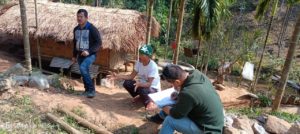Guwahati, Feb 9: One of the leading research-oriented biodiversity conservation organisations in India, Aaranyak (www.aaranyak.org) has been conducting an Elephant Occupancy Survey in Meghalaya that is expected provide effective ways for mitigation of human-elephant conflict as well as boosting conservation.
The organization involved in dedicated efforts for mitigating the burgeoning human-elephant conflict in Northeast India, has completed the first phase of the survey in West Garo Hills, East Garo Hills, South West Garo Hills, North Garo Hills, West Khasi Hills, South West Khasi Hills, Eastern West Khasi Hills and Ri-Bhoi districts of Meghalaya.
The survey is being conducted in collaboration with the Forests and Environment Department, Meghalaya with the support from the US Fish and Wildlife Service of the United States.
“Meghalaya has one of the highest densities of elephants in the country. The latest elephant census in Meghalaya was carried out from 26-03-2017 to 29-03-2017 using dung decay count method. As per the census there are 1754 elephants in Meghalaya,” according to the official website of the Forests and Environment Department, Meghalaya.
“In current survey, elephant distribution in the state is being analysed. Genetic analysis of dung samples will be conducted at the Wildlife Genetics Laboratory at Aaranyak whose team will also do estimation of elephants in Balpakram National Park in Meghalaya using a variety of scientific methods. In following up on the survey, Aaranyak will utilize a variety of methods to mitigate human-elephant conflict in the state,” said Aaranyak’s senior researcher, Abhijit Boruah who is leading the survey team.
Many of Aaranyak’s researchers and field staff are involved in this critical survey, including another senior researcher Rubul Tanti and field investigators Rupam Goyari, Prodip Barman, and Dibakar Nayak.
Using occupancy models, conservation interventions can be guided according to where a species occurs and why, as well as the status of rare and threatened wildlife. In this region of highly fragmented elephant distribution, little quantitative research has been done previously on elephants and their habitats. Through occupancy survey major intervention can be guided in terms of habitat which is linked to human elephant conflict.
Elephants, the gentle jumbos, contribute to the vitality of forests and savanna ecosystems and to human wellbeing. Elephants are important ecosystem engineers. In dense forests, they create pathways that allow other animals to pass.
Study on forest fringe people
Aaranyak is also working with the Forest Department of Meghalaya to help the latter understand socio-economic status, nature and extent of forest dependency of the families living in the forest fringe areas of three landscapes, namely, Narpuh, Nongkhyllem and Balphakram through a comprehensive study supported by the department.

The study, nearing completion, would provide the key background and knowledge about the communities living in the forest fringe villages and carry out appropriate planning to reduce their excessive dependence on natural resources so that sustainable and green livelihood actions can be planned for long term forest conservation and mitigation of climate change impacts in the near future.
In addition, Aaranyak is also supporting the department in conducting extensive camera trapping in some of the key areas with resources, manpower and technical and scientific expertise to monitor various key species of wildlife.



